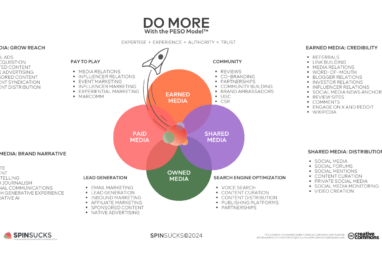Thought leadership in B2B comms
About the author
Our guest authors are what make PR Place such a vibrant hub of information, exploration and learning.

This guest post by Daria Partas is based on a submission for a CIPR Professional PR Diploma assignment, studying with PR Academy.
The ideas shared in this article are underpinned by my extensive experience of working as a public relations practitioner across industries, clients and geographies. The evidence is mostly rooted in a case study but is nonetheless guided by the foundational principles of public relations. I do hope that readers will find my experience useful, for it allows practitioners to re-think communications practice by helping organisations to make the end-product of their endeavours establishing an authentic thought leadership practice. Importantly, I also hope my peers will find this article useful in re-establishing their roles in content development and gaining credit as reputational advisers within their organisations.
The effectiveness of Thought Leadership as a marketing tool
Much hyped ’thought leadership’ is understood as a necessary tool in B2B marketing by many businesses. The responsibility for developing ‘thought leadership’ content often lies within marketing departments. This can be evidenced, for example, by the high volume of vacancies open for Content Managers or Content Marketing Managers on job search sites. These people are tasked with ‘developing and distributing engaging content which can become viral’, ‘developing and implementing thought leadership campaigns’ or ‘implementing of ongoing thought leadership activity throughout the year with trade media’ (quoted from random job descriptions on LinkedIn Jobs).
The end-product of such marketing activity may take different shapes and forms. Some common examples include by-lined articles placed under a ‘sponsored content’ tag on trade media websites, reports, white papers, survey results, lengthy video interviews with a company’s expert, or sharing some proprietary data in the form of infographics on a company’s social media page. These tools represent tactical steps of a ‘content marketing strategy’, defined by the Content Marketing Institute as ‘a strategic marketing approach focused on creating and distributing […] content to attract and retain a clearly-defined audience —and, ultimately, to drive profitable customer action”. As such, Content Managers are rightfully expected to measure the effectiveness of their work by the amount of leads generated.
Maintaining such activity is also quite a costly affair. For example, a White Paper may take up to 6 months or more to produce, since adequate field research which backs it up may take several months to conduct. Once the White Paper is ready, a press release with key findings will be written by a Media Relations Officer or by a rostered PR agency with a view to generating media coverage counting towards the thought leadership campaign’s ROI.
Further communication channels are employed to ensure wider distribution of the White Paper. It will have a designated page on the corporate website with links shared across the company’s social media channels, and will be used in customer newsletters. Some extra budget may be allocated for sponsored posts on social media, especially on LinkedIn which has now carved out its niche as a flagship platform for B2B marketing.
Assuming that sponsored posts have indeed generated clicks through the link to the White Paper, the chances that it will be read from cover to cover are very low. Most likely, even the carefully crafted foreword from the CEO will be skimmed through at best. Once this is understood by the White Paper marketers, they will attempt to use the Paper as a reference in the speech written for the CEO for an upcoming industry forum. The paper might even be put in print to be handed out in delegate bags along with branded pens, cups and notebooks. At this point, the paper is living its own life and its original purpose is likely to have been lost from sight.
Unhelpfully for old-school marketers, some external socio-technological forces interfere with the efforts of spreading ‘thought leadership’ content.
Attention spans are at all times low, content consumption patterns have changed dramatically with the rise of social media and generally with the rise in the quantity of content available, while algorithms create filter bubbles which are really tricky to break without a considerable financial backup. At the same time, content marked as ‘sponsored; even if delivered to the eyes of the target audience has higher chances of being registered as advertising and has less potential to be trusted by its readers.
Thought Leadership as a means to build trust in B2B communications
I take these developments as problematic because they undermine the very concept of thought leadership – with the word leadership as the key to understanding it.
According to the Reputation Institute, a company’s reputation is constructed through its efforts to communicate across seven dimensions, leadership being one of them. Moreover, it is argued that a company’s enterprise dimensions are much more important for the overall reputation score than its product-based dimensions. The leadership dimension in the suggested RepTrak model by the Reputation Institute assesses perceptions of leaders as excellent and visionary managers. Indeed, the senior leadership team of an enterprise can be an important catalyst for generating trust with stakeholders.
Appealing leaders attract favourable media coverage and investor confidence, thereby signalling to all stakeholders the credibility of the company’s activities, increasing trust in the company.
The idea of trust is central to the theories of reputation management. Building trusted relationships with stakeholders, or publics, is the primary pre-occupation of the PR profession.
The fact that thought leadership in an organisation is often seen to be in the wider remit of its marketing department presents a problem, for the aim of such activity must be to establish trust with the publics as opposed to generating leads. Thought leadership may with time result in a sales surge but its primary focus should be on building trust.
This has been echoed by business leaders around the world. For example, Daniel Rasmus, author and former director of business insights at Microsoft once said: “Thought leadership should be an entry point to a relationship. Thought leadership should intrigue, challenge and inspire even people already familiar with a company. It should help start a relationship where none exists and it should enhance existing relationships”.
The specifics of B2B communications are such that customers have a much more direct and intimate contact with an organisation than those in the consumer market. Companies tend to allocate individual account managers, or even account teams, to their B2B clients. This of course presents opportunities to influence customers directly, without mediators, prioritising customers themselves over other stakeholder groups which a PR practitioner would traditionally work with such as the media or analysts.
In B2B communications, trust built on personal relationships becomes ever more central to PR and marketing, even more so with the development of alternative communication channels which allow information exchange in a less formal setting.
A B2B customer is highly likely to engage with their account team should they have a question about a company before looking for answers elsewhere – in the media or browsing through a company’s website. In parallel, according to Edelman’s Trust Barometer 2018, while brand loyalty and trust are at all time low, there is a rebound faith in experts and leaders whose voices are gaining in credibility. For B2B businesses this presents an excellent opportunity to capitalise on the collective intelligence of their experts by establishing and developing a sustainable thought leadership practice and by doing so wielding influence on stakeholders, both internal and external.
Social technology requires social leaders
With more communications channels than ever before, leaders and leadership teams have ample opportunities to engage and interact with their stakeholders across multiple platforms, including social media. It is common now to be contacted by a potential customer via LinkedIn inMail or Facebook Messenger. It is also a norm to befriend or follow representatives of various stakeholder groups on social media. Relationships formed via social media represent the quintessence of modern communications which have a networked nature.
Linear models of message delivery have been replaced by networked models of information sharing.
The multiplicity of touch points between an organisation and its publics implies the need for rather niche customisation of communication messages. This is especially true when a company serves customers across industry verticals. For an organisation to employ a PR team strategising and developing separate messaging frameworks for niche customer segments would be inefficient and probably ineffective. Social media makes this task easier, given it is employed by a company’s customer-facing team as a standard business communication tool. Social media have also made relationships between organisations and their stakeholders visible and public. The same principle applies to thought leadership practice. Organisations have always done it – face-to-face meetings, emails, knowledge calls, webinars have all been available channels of sharing expertise.
The point I am making is that ‘thought leadership’ activity must not be seen as, and mistaken for, marketing activity.
Thought leadership which takes form of a column in a respected newspaper or an article in a professional magazine or a blog posted on LinkedIn is and should be a continuation of the daily business routines of senior decision-makers in the business.
Thought leadership should not be a parallel activity to any other stakeholder-facing communication. The line between external and internal communications has been further blurred. Equally, a piece of advice rendered to a customer in a face-to-face meeting can be re-purposed into an article on LinkedIn, later pitched to a trade journalist and further referenced at an industry forum.
Rethinking the role of PR practitioners in developing Thought Leadership practice
In this new socio-technological paradigm, what is the role of the PR practitioner? Communication scholar Jim Macnamara has offered a new model for PR in which “centralised control paradigm ‘gatekeeper’ units are dismantled and replaced by professional communicators acting as advisers, trainers and facilitators of communication”.
Indeed, in order to help an organisation build a sustainable thought leadership position, communication professionals, first and foremost, need to re-think their role in the content development process.
Rather than being content originators or content producers, PR managers must become content editors and content curators ultimately aiming to establish a self-sustained communications ecosystem.
In a typical PR role there is a larger focus on establishing effective relationships with certain groups of stakeholders, for example with the media or a narrow group of identified influencers with the view to use the media platforms controlled by these groups to promote and land a message. However, there is a much lesser focus on growing influencers within an organisation and building a fit-for-purpose branded publishing platform set to serve as the knowledge centre of a larger communication ecosystem. For practitioners working in B2B communications, coaching and training knowledge experts within the company should be a matter of priority.
The coaching element is needed to convey the importance of developing communication skills by the company’s experts. Often when I speak with senior executives who I’d like to see more engaged in the public domain, I notice that they tend not to think of themselves as credible thought leaders or as authorised to speak on behalf of the brand or a company in the public domain. What they might not realise is that speaking with a client at an industry forum they are already doing just that.
Communication is an essential leadership skill.
It is primarily used to develop authority on the topics of subject matter expertise, to inspire teams and to win hearts. Caroline Goyder in her book Gravitas evokes Cicero who taught that emotion is an undeniable component of the art of rhetoric.
Often leaders withhold emotions failing to connect with the audience and delegating this task to the brand persona carefully constructed by brand marketers. In B2B communications this becomes harder to achieve because interaction with the stakeholders occurs in a more intimate environment and is less often influenced by intermediaries. Therefore, conventional forms of ‘thought leadership’ content such as white papers which bear no author’s name become rather devalued in building trust.
Personal blogs or opinion pieces build emotional bonds with their readers by allowing the author to evoke personal experiences, express personal views on the subject matter and arouse sympathy. Ultimately, the thought leadership activity in B2B communications must have a face. The idea behind this is to move from branded content to personal content produced by a human for a human, or moving from brand to the network of experts and trusted advisers.
This idea would be difficult to implement without social media, therefore thought leadership as a distinct practice has evolved hand in hand with social media as its main communication channel. In the era before ‘social’, what we today call thought leadership could have been simply called gossip. I find it interesting how Yuval N Harari argues in his acclaimed book Sapiens that gossip is the primary tool for social beings to build or destroy trust. In other words, gossip allows people to pass on reliable information, or stories that can be trusted, to their networks.
The training element of a PR practitioner’s role lies in preparing a company’s thought leaders for public engagement. This may include media handiing and public speaking training, workshops on how to use social media as a business communication tool. It may also involve some editorial work on the expert articles and blogs.
Equally, content managers must shift their focus from content origination to developing a strategic approach to content distribution, and work together with PR practitioners to build a scalable, agile and flexible communication ecosystem populated with relevant content, fit for the socio-technological reality of the modern world.
Modernity demands that all have technical knowledge to use social media in business communications. Those executives who find themselves in a state of denial need to re-think their Luddite views and establish their online public presence as soon as possible. This means understanding their role in organisational thought leadership and identifying the best way to connect with and relate to their stakeholders while also connecting their activity with their company’s brand aspirations and business goals.
Where to start? Practical steps for PR practitioners
Talk about efficiency and cost effectiveness in business often results in redundancies across ‘support functions’ which usually means bad news for PR and marketing teams. If a lean PR team is serving a complex B2B business with a matrix structure, operational priority must be given to clear capacity for conducting in-depth workshops with the senior management team of the business with the view to understand the core of the business strategy and identify major reputation challenges which impede this business from further commercial success.
In close partnership with the business head, a communications strategy with agreed KPIs must be developed. I cannot overemphasise the necessity for in-depth reputation research with regional and vertical granularity although sponsoring such research is not always an available option within the context of an ever-increasing need for operational efficiency. Some customer insight might be available from the brand and NPS (Net Promoter Score) trackers, but it is often insufficient to identify more specific reputation challenges, especially if a business operates across industries and geographies.
This presents a trap for a PR team which will struggle to back up the reputation strategy with credible research while operating with a constrained delivery resource. This certainly is not a sustainable operational model for a small PR department. Here the answer comes in the shape of a culture change at the top.
Authors specialising in reputation management and think tanks researching this field, unanimously agree that organisational leadership plays an essential part in building trust with stakeholders and publics. This idea is even reflected in many CEOs’ employment contracts where they are held responsible for the company’s reputation.
This is not news of course, however, the novelty is in pushing this notion even further so that is the management team is not only responsible for the company’s overall reputation but also for the development of content, or storytelling, and its delivery to the array of stakeholder groups through available and appropriate communication channels. Recognition of this responsibility by the senior management team has become a deal breaker in the way B2B communications are run by my team.
This idea draws from the notion that great communication skills are essential for leaders. In leadership, there is no possibility to opt out from sharing information, or communicating with the company’s publics.
The development of social media platforms and the way they have changed how we consume information demands that leaders adopt ‘social’ not just as a business communication tool but as a mode of living and doing business. In the startup culture, social is interwoven into the working routine; for many businesses their Instagram or Facebook page comes first, before the official registration of the company. More conservative organisations may require time to adapt – the job of communications professionals lies in fostering this change of culture, starting from the top.
This method of delegating responsibility for content development to the senior management team draws on a number of connecting theories. While reading Sapiens by Yuval Harari, I found his take on gossip really refreshing. At work, I often find myself combating disconcerting views of PR held by people in senior positions.
‘PR’ was described to me as ‘fluffy’, something that is a ‘nice-to-have’ but not particularly important or essential for commercial success.
Even more troubling was to learn that senior managers intentionally withheld information from the PR teams for the fear that sensitive information would be leaked to the media. What is overlooked in such broken structures is that gossip, or in other words information sharing, is central to the process of building trust. In the era of social media platforms, ‘gossip’ regains its role in peer-to-peer communications facilitated and liberated by the social nature of digital platforms. Some see danger in the negative connotations of the word ‘gossip’. It is, therefore, essential to focus on the social aspect of it and the idea of sharing knowledge for the sake of building trust which allowed us, Homo Sapiens, to construct functioning societies.
In reputation management theory, trust is undeniably the central idea. Graham Sutherland, former CEO of BT Business and Public Sector, placed trust at the heart of his business strategy with one the main objectives in the five year plan ‘becoming Trusted Customer Advisers for the UK major businesses and the public sector’. The whole business unit was re-organised to achieve this objective. For example, a new team of Chief Information Officers (CIOs) was formed to reflect the company’s approach to serving its B2B customers. A key function of the new CIO team was to act as the ‘voice of the customer’ within BT, to ensure the right solutions are developed to meet their current and future needs.
To help a business to achieve the objective of enhancing trust with its publics, I recommend working with the senior leadership team on establishing a sustainable communication ecosystem where knowledge sharing in the public domain would become a naturally occurring continuation of the usual client meetings, webinars and workshops.
Expertise developed for one communication channel could be re-purposed for any other channel – otherwise, advice lent during a face-to-face meeting with a client remains confined by a moment in time and by the walls of a meeting room. A speech delivered at an industry event cannot be shared in full by the attending audience. So why not allow the ‘social’ technology to facilitate distribution of useful content by posting it on a social platform?
This change in leaders’ self-perception as storytellers may actually come fast with some targeted work. In my previous role as the Head of B2B PR at BT, I worked with the social media team to develop a workshop which aimed to land the idea of leadership as an important driver of reputation. Once that was agreed amongst the participants, we would move to explore the role of thought leadership. We drew on The Sophisticated Marketer’s Guide to Thought Leadership, a study by LinkedIn which I found particularly helpful in explaining how to pick an appropriate type of thought leadership depending on the executive’s role in the organisation.
The workshop also provided some practical tips on how to build a fit-for-purpose public profile; how to write articles and which topics to choose; and even how to approach sharing posts reflecting on the ideas discussed at a meeting or a client event or sharing the learning outcomes of an award-winning project or initiative. The workshop also covered how BT’s purpose and corporate narrative could be reflected in the ‘thought leadership’ content produced.
The responsibility for the communications output was assumed by the senior leadership team, freeing up the lean PR team. Instead, we focused on helping our home-grown experts to formulate their ideas and worked largely with their communication style rather than the content itself. Today, BT’s B2B experts write blogs and post articles on their LinkedIn profiles which online trade media like to re-publish.


